

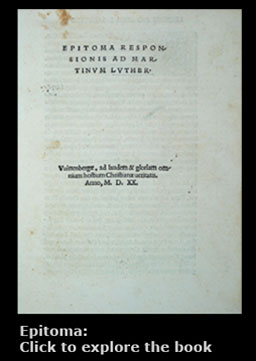
Pope Leo X assigns his close advisor Sylvestre Mazzolini Prierias to examine Luther's "Ninety-Five Theses," which had been forwarded to Rome by the Archbishop of Mainz.
Prierias publishes his opinion, called "Dialogus," in which he defends papal infallibility and accuses Luther of heresy. On the basis of this opinion, Luther is summoned to Rome.
In Luther's response, called the "Epitoma," he declares that Scripture alone is the infallible authority. He asks why it was considered heretical to debate theological questions that had not yet been made into official dogmas.
Prierias had asserted that "a Pope not accused of heresy or schism cannot lawfully be deposed or judged…even if he is so scandalous as to lead people into the possession of Hell," to which Luther responded, "Be astonished, O Heaven! Shudder, O Earth! Behold, O Christians, what Rome is!"
Luther makes some of his most revolutionary statements up to that time, urging the Emperor and Princes if necessary to eradicate the Cardinals, the Pope, "and that whole crew of Roman Sodom who corrupt the Church of God without end!"
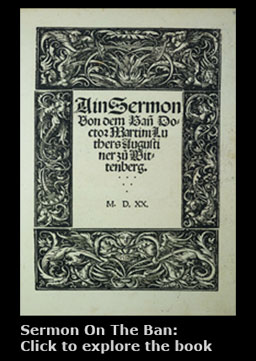
Luther's "Sermon on the Ban" was motivated by his pastoral concerns for proper ecclesiastical practice. In a previous sermon on the ban, or excommunication, Luther complained of how power was being misused.
According to Luther, the ban, like letters of indulgence, was being used to enforce fiscal policies. Christians had been "banned" because of failure to pay ecclesiastical dues and other fees on time.
Luther's sermons caused much consternation among church authorities because he was inciting the people to defy the ban in the name of a righteous cause. A public debate on this subject was not possible, so Luther continued to preach and warn the people of Wittenberg about this very grave issue.In this sermon, Luther discusses what it means to be put under the ban. He asserts that a man is not condemned as a result of violating some external ecclesiastical law; rather he is condemned on the basis of his own sin and unbelief. Luther defines sin as a lack of trust in God's grace.
"The Ban" (Excommunication):
The term "excommunication," from the Latin "excommunicare," was coined in the 4th century. By the 12th century, it was also called "The Ban," which in ancient jurisprudence denoted a declaration of a person being "outlawed." The original intent of the ban, before its abuses, was to bring about a right attitude with the hopes of restoration after repentance.
Roman Catholic Canon Law cites eighty-one reasons for enforcing the ban, including heresy or any attacks on the papacy or the Roman Curia (papal administrative system), cardinals, clerics, churches, or pilgrims; as well as fiscal failure to pay special fees and taxes on the part of the poor, failure to comply with religious instruction, and civil disobedience.
There are two categories of the ban: "major" (sometimes called anathema) and "minor." Major excommunication meant that a person would be cut off from human contact, including communal meals, conversation, reception of the sacraments, and participation in the spiritual goods of the church, including blessings. Many times the banned person would be forced to flee their city or town of residence.
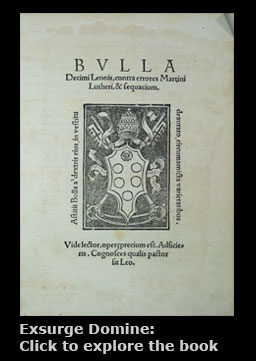
Accused of heresy, Luther refuses to recant. Pope Leo X then issues the bull entitled "Exsurge Domine," or "Arise O Lord." It is the counter-manifesto to Luther's "Ninety-Five Theses," condemning forty-one of the theses and giving Luther sixty days to respond and recant. The whole bull resonates with arrogance, feigned concern for the truth, and penal severity.
This particular copy of "Exsurge Domine" was reprinted by a friend and champion of the Reformation, Ulrich von Hutten. This edition features Hutten's polemical preface and side notes. In his preface, Hutten advises the Pope to "keep his bulls to himself" and to "not bother the German Protestants any longer."
Of great significance, "Exsurge Domine" was the last papal bull addressed to Latin Christendom as an undivided whole, and the first that was disobeyed by a large part of it. The last words from Hutten on the final leaf say it all: "Let us break the chains and cast off the yoke of those who bind us!"
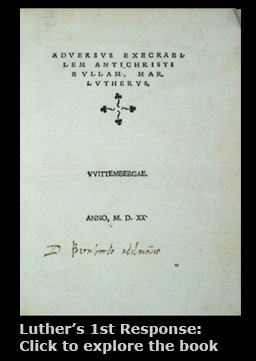
Bernhard Adelmann was canon of the Augsburg Cathedral. This was his personal copy of Luther's response to the bull that named them both as heretics. Adelmann met Luther at the Diet of Augsburg in 1518, where Luther had been summoned by the Pope's cardinal legate, Cajetan. Adelmann took a warm interest in Luther and the two began a lively correspondence.
In December 1520, Adelmann wrote Luther to tell him he had escaped excommunication, having been spared by the intervention of the Duke of Bavaria. After that, Adelmann remained outwardly obedient to Rome, while privately supporting Luther in spirit. This is the first of four answers to the papal bull "Exsurge Domine."
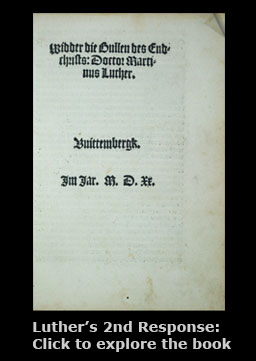
Luther condemns the papal bull as blasphemy against Christ. He emphatically declares that "Anyone who agrees with this bull is the antichrist and must be avoided." Luther decrees that his own articles, condemned by the bull, were obligatory doctrine for every Christian under pain of eternal punishment. He goes on to discuss the first twelve of his "condemned" articles.
He declares that, by his own authority as a baptized child of God and co-heir with Christ, standing as Peter did on the rock which the gates of hell could not overcome, he would call on the Pope, Cardinals and all Romans to repent.
If they did not repent, Luther, along with all those who honored Christ, would regard the Roman See as occupied by Satan and as a seat of antichrist, which he would no longer obey and to which he would no longer belong. Instead, he would curse them as the chief enemy of Christ, an enemy whose punishment he was happy and willing to bear and whose absolution he considered of no value.
Luther’s position was unmovable. He would prefer to be "killed a thousand times" than to "retract one article. . . . As they excommunicate me according to their blasphemous heresy, so I excommunicate them according to the holy truth of God. Christ as the judge will see which excommunication he deems valid."
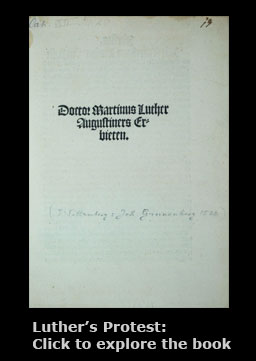
Luther wrote his "Protest" and sent it to Rome specifically in response to a letter that Cardinal Riario had written to Frederick the Wise III. Riario had tried to pressure Frederick into forcing Luther to recant or face the consequences. Frederick allowed Luther to respond directly to Riario and make it appear as though the response came from Frederick. In his "Protest," Luther, writing as though he were Frederick, proposed that his doctrine be evaluated by a panel of impartial judges, rather than by the Roman Curia.Riario’s letter had deeply affected Luther, as seen in a letter written by him to his friend Spalatin:
"My die is cast; I despise the fury and favor of Rome. I will never be reconciled to them nor commune with them. Let them condemn and burn my books. On my side unless all the fire goes out, I will condemn and publicly burn the whole papal law, that slough of heresies. The humility I have hitherto shown in all vain shall have an end, lest it still further puff up the enemies of the Gospel. The more I think about Cardinal Riario’s letter I despise it. I see they write with cowardly fear and a bad conscience. They try to protect their folly by force, but they fear they will not succeed as happily as they have in times past. But I have no doubt the Lord will accomplish his purpose through me, though I am a foul sinner."
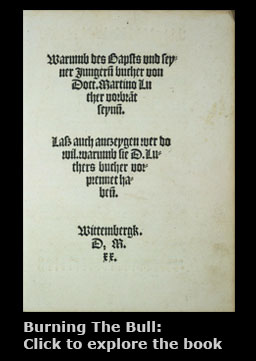
In December 10th, a crowd of students and teachers gathered at nine o’clock in the morning at the chapel of the Holy Cross, and from there proceeded to a place outside the Elster gate in Wittenberg.
There, Luther stepped from the crowd and cast into the fire volumes of canon law, papal decretals and scholastic philosophy. Then Luther, deeply agitated, consigned another document to the mounting flames: the papal bull threatening his excommunication. This was a moment in time marking an absolute break with Rome.
In his treatise Luther says, “From all time it has been custom to burn impious books.” As a Doctor of Holy Scripture, he wrote that he was bound to suppress bad books; if others from ignorance or human respect neglected to do this, it did not free him from the responsibility. His writings had already been burned at Cologne and Louvain, which raised suspicion against him among the ignorant. Therefore he was justified in burning the books of his adversaries, being prompted by the Holy Ghost. He also enumerates thirty propositions taken from canon law and papal decretals that he says should be destroyed. In his prologue he states the reason for his actions: he felt it was his duty to drive away all misleading doctrine. Because the Pope and his officials had refused to listen to Luther’s instructions and warnings, he was bound to take action.
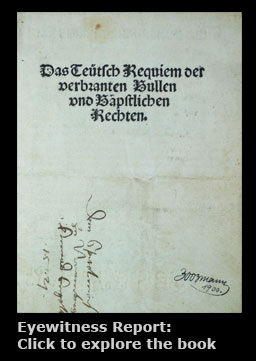
An eyewitness report of Luther burning the papal bull “Exsurge Domine” focuses on the theological significance of the event, rather than on historical details. This pamphlet has been falsely attributed to Luther or Hutten in the past. All five printings are exceedingly rare. Only six copies of this work have been located in the world, as follows: one in Princeton, one in Wisconsin and one in Emory; two copies are at Folger and one copy is in the Scott Collection.
In January of 1521, Pope Leo X will issue another papal bull, the “Decet Romanum Pontificem,” in which he officially excommunicates Martin Luther and several of his followers. In December of that same year, Pope Leo X will unexpectedly die.
There are now over 800,000,000 Protestant Christians in the world today, which is more than one-third of the world’s total Christian population.